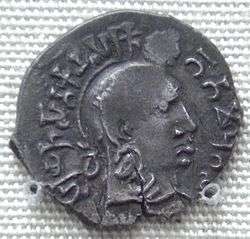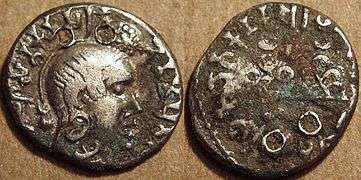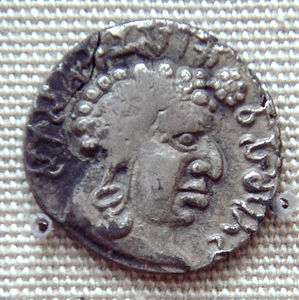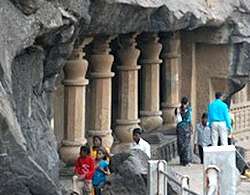Yajna Sri Satakarni
Yajna Sri Satakarni (Brahmi: 𑀲𑀺𑀭𑀺 𑀬𑀜 𑀲𑀸𑀢𑀓𑀡𑀺 Siri Yaña Sātakaṇi), also known as Gautamiputra Yajna Sri,[1][2] was an Indian ruler of the Satavahana dynasty. His reign is dated variously: c. 152-181 CE,[3] c. 165-195 CE,[4] c. 170-199 CE[5] or c. 174-203.[6]
| Yajna Sri Satakarni | |
|---|---|
  Coin of Yajna Sri Satakarni, with coin legend in the Brahmi script (starting at 12 o'clock). British Museum | |
| Last Satavahana King | |
| Reign | 2nd century CE |
| Successor | Vijaya |
| Satavahana Empire 100 BCE–2nd c. CE | ||||||||||||||||||||||
|---|---|---|---|---|---|---|---|---|---|---|---|---|---|---|---|---|---|---|---|---|---|---|
|
||||||||||||||||||||||
He is considered to be the last great king of the Satavahana dynasty. He regained some of the territory lost to Shakas (the Western Satraps) under Vashishtiputra Satakarni. He defeated the Western Satraps and reconquered their southern regions in western and central India.[7] The Satavahana started to decline after Yajna Sri Satakarni, while the Western Satraps would continue to prosper for another two centuries.
Coinage
 Coin of Gautamiputra Yajna Satakarni
Coin of Gautamiputra Yajna Satakarni Coin of Gautamiputra Yajna Satakarni
Coin of Gautamiputra Yajna Satakarni
Inscriptions
There are two inscriptions of Yajna Sri Satakarni at Kanheri, in cave No.81,[8] and in the Chaitya cave No.3.[9]
In Nasik Caves, Cave No.20 has one large inscription, claiming that the unfinished cave was completed by the wife of a great general named Bhavagopa, during the 7th year of the rule of king Sri Yajna Satakarni, son of Gotami, after having been started by the ascetic Bopaki.[10][11].
These inscriptions show that the Satavahanas were in possession of the areas of Kanheri and Nasik during the reign of Sri Yajna Satakarni.
He is also known from his coins, and from the mention of his name in the regnal lists of the Matsya Purana, in which he is said to have ruled 29 years.[12]
| Nasik Caves, Cave No.20 "Sri Yajna vihara" (circa 180 CE) | |
|
Cave No.20 at the Nasik Caves has one large inscription, claiming that the unfinished cave was completed by the wife of a great general named Bhavagopa, during the 7th year of the rule of king Sri Yajna Satakarni, son of Gotami, after having been started by the ascetic Bopaki.[10][13] There are similar inscriptions of Sri Yajna Satakarni in cave 3 and cave 81 at Kanheri. This means probably that the cave was carved in the end of the 2nd century CE. It also shows that the Satavahanas reclaimed the area of Nasik under Sri Yajna Satakarni.
| |
References
- Pran Nath Chopra (1994). Encyclopaedia of India: Andhra Pradesh. Rima. p. 12.
- Vijaya Laxmi Singh (1998). Ujjayini, a numismatic and epigraphic study. Khama. p. 121. ISBN 978-81-85495-47-7.
- Carla M. Sinopoli (2001). "On the edge of empire: form and substance in the Satavahana dynasty". In Susan E. Alcock (ed.). Empires: Perspectives from Archaeology and History. Cambridge University Press. pp. 166–168.
- Rama Shankar Tripathi (1942). History of Ancient India. Motilal Banarsidass. p. 196.
- Pran Nath Chopra; T. K. Ravindran; N. Subrahmanian, eds. (1979). Ancient period. S. Chand. p. 25.
- Alain Daniélou (2003). A Brief History of India. Inner Traditions. p. 137.
- "later Satavahana named Yajna Satakarni seems to have conquered the Southern Dominions of the Western Satraps. His coins contain figures of ships, probably indicating the naval power of the Andras. He not only ruled Aparanta, but probably also the eastern part of the Central Provinces". Majumdar, p. 135
- Burgess, James; Bühler, Georg (1883). Report on the Elura cave temples and the Brahmanical and Jaina caves in western India; completing the results of the fifth, sixth, and seventh seasons' operations of the Archaeological survey, 1877-78, 1878-79, 1879-80. Supplementary to the volume on "The cave temples of India.". London, Trübner & Co. p. 79.
- Burgess, James; Bühler, Georg (1883). Report on the Elura cave temples and the Brahmanical and Jaina caves in western India; completing the results of the fifth, sixth, and seventh seasons' operations of the Archaeological survey, 1877-78, 1878-79, 1879-80. Supplementary to the volume on "The cave temples of India.". London, Trübner & Co. p. 75.
- Epigraphia Indica p.93 Inscription No.22
- Burgess, Jas (1883). Archaeological Survey Of Western India. p. 114.
- Rao 1994, p. 14.
- Burgess, Jas (1883). Archaeological Survey Of Western India. p. 114.
- "A Catalogue of Indian coins in the British Museum. Andhras etc..", Rapson
| Preceded by: Shivaskanda Satakarni. |
Satavahana ruler 2nd century CE |
Succeeded by: Vijaya |
Book sources
Rao (1994), History and Culture Of Andhra Pradesh: From the Earliest times to the present day, Sterling Publishers, ISBN 81-207-1719-8


.jpg)
.jpg)
.jpg)